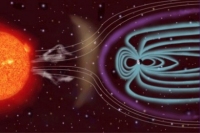Solar Wind
 |
|
The Sun's magnetic field and plasma releases directly affect the Earth and the rest of the Solar System |
What chemical elements are represented in the solar wind?
The proportions of the various constituents and the extent of their ionization (loss of electrons) are different in the slow and fast solar windstreams. This information feeds back into the theories of how the solar wind is created.
Is the solar wind equal in all directions?
Coming typically from the Sun's equatorial region, the slow windstream remains more concentrated than the fast wind, which spreads out to fill most of the heliosphere. Moreover, the slow wind is more effective in stripping electrons from the interstellar hydrogen. The groove was very clear when the Sun was quiet (1996-97) but the picture is likely to be more complicated at the maximum of solar activity (2000).
Where do the alien atoms come from?
From the direction of the constellation Ophiuchus, near to Scorpius. The Sun's deflection of the passing atoms has a focusing effect, creating a solar halo of interstellar helium.
What becomes of the alien atoms?
Most of them continue on their way, back to interstellar space, after passing through the Solar System. They are swept away towards the boundary of the heliosphere, many billions of kilometres away. But some of these pick-up ions are then accelerated back towards the inner Solar System, as 'anomalous cosmic rays'. Other wanderers replace their missing electrons and return as energetic hydrogen atoms.
